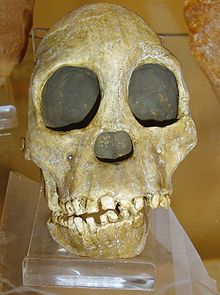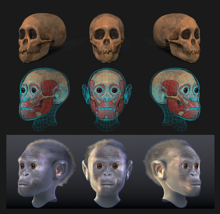Taung Child: Difference between revisions
| Line 43: | Line 43: | ||
[[File:Taun child - Facial forensic reconstruction.png|thumb|Taun child – Facial forensic reconstruction by Arc-Team, Antrocon NPO, Cicero Moraes, University of Padua]] |
[[File:Taun child - Facial forensic reconstruction.png|thumb|Taun child – Facial forensic reconstruction by Arc-Team, Antrocon NPO, Cicero Moraes, University of Padua]] |
||
and i think that bone is palidhje ahhahahahhahaha by jona and agan |
|||
==See also== |
==See also== |
||
Revision as of 17:55, 9 October 2013
 | |
| Catalog no. | Taung 1 |
|---|---|
| Common name | Taung Child |
| Species | Australopithecus africanus |
| Age | 2.5 mya |
| Place discovered | Taung, South Africa |
| Date discovered | 1924 |
The Taung Child (or Taung Baby) is the fossilised skull of a young Australopithecus africanus individual. It was discovered in 1924 by quarrymen working for the Northern Lime Company in Taung, South Africa. Raymond Dart described it as a new species in the journal Nature in 1925.
The skull is in repository at the University of Witwatersrand.[1]
History
In the early 20th century, workers at limestone quarries in southern Africa routinely uncovered fossils from the tufa formations they mined. Many were of extinct fauna, which included baboons and other primates, and the more complete or somehow more interesting fossils were kept as curios by the Europeans that managed operations.[2]
In 1924, workers at the Buxton Limeworks near Taung, South Africa showed a fossilised primate skull to E.G. Izod, the visiting director of the Northern Lime Company, the managing company of the quarry. The director gave it to his son, Pat Izod, who displayed it on the mantle over the fireplace. When Josephine Salmons, a friend of the Izod family, paid a visit to Pat's home, she noticed the primate skull, identified it as from an extinct monkey, and realised its possible significance to her mentor, Raymond Dart.[2]
Josephine Salmons was the first female student of Dart, an anatomist at the University of Witwatersrand. Salmons was permitted to take the fossilised skull and presented it to Dart, who also recognised it as a significant find. Dart asked the company to send any more interesting fossilised skulls that should be unearthed. When a consulting geologist named Robert Young paid a visit to the quarry office, he relieved the manager, A.E. Spiers, of a collection of fossilised primate skulls that had been gathered by a miner known as Mr. De Bruyn. Young sent all the skulls back to Dart.[2] When Dart examined the contents of the crate, he found a fossilised endocast of a skull, showing the impression of a complex brain, and matched it to a fossilised skull of a juvenile primate, which had a shallow face and fairly small teeth.[2] After a complete examination, he published the discovery in 1925, describing the new species of Australopithecus in the journal Nature. It was soon nicknamed the Taung Child.
The idea that the skull belonged to a new genus was identified by comparison with skulls of chimpanzees. The endocast of the Taung child was larger than a fully grown chimpanzee's. The forehead of the chimpanzee receded to form a heavy browridge and a jutting jaw; while the Taung child's forehead recedes, but leaves no browridge. The Taung child's foramen magnum (a void in the cranium where the spinal cord is continuous with the brain) is located beneath the cranium, showing that the creature stood upright.[3]
The British scientific establishment was at the time enamored with the hoax Piltdown Man, which had a large brain and ape-like teeth – the exact opposite of the Taung Child – and Dart's interpretation was not appreciated for decades.[4]
Description


The fossil consists of most of the face and mandible with teeth and, uniquely, a natural endocast of the braincase. It is estimated to be 2.5 million years old. Originally thought to have been a monkey or ape, Dart realised that the skull would have been positioned directly above the spine, indicating an upright posture. This is a trait seen in humans, but not other primates.
The Taung Child was originally thought to be about six years old because of the presence of deciduous teeth, but is now believed to have been 3–4 based on studies of rates of enamel deposition. It was a creature standing 3' 6" (105 cm) and weighing about 20–24 pounds (9–11 kg). It had a cranial capacity of 400–500 cc[5] and lived mainly in a savanna habitat.
Examinations of the Taung Child fossil compared to that of an equivalent 9-year-old child suggest that A. africanus had a growth rate to adolescence more similar to that of modern apes like chimpanzees (genus Pan) than to that of modern Homo sapiens. However, intermediate species such as Homo ergaster/Homo erectus are thought to have gone through growth rates intermediate between modern humans and apes. This conclusion has mostly been based on the Turkana Boy fossil discovered in 1984.
In early 2006 it was announced that the Taung Child was probably killed by an eagle or similar large predatory bird. This conclusion was reached by noting similarities in the damage to the skull and eye sockets of the Taung Child with damage to the skulls of modern primates known to have been killed by eagles.[6]
In popular culture
A hologram of the skull appeared on the cover of the Nov. 1985 issue of National Geographic, in one of the pioneering uses of holograms in mass-market publications (a smaller hologram of an eagle had appeared on an earlier issue).[7]


and i think that bone is palidhje ahhahahahhahaha by jona and agan
See also
References
- ^ Štrkalj, Goran; Kaszycka, Katarzyna (November/December 2012). "Shedding new light on an old mystery: Early photographs of the Taung Child". South African Journal of Science.
- ^ a b c d McKee, Jeffrey K. The Riddled Chain: Chance, Coincindence, and Chaos in Human Evolution. New Brunswick, NJ: Rutgers University Press. pp. 40–41.
- ^ Fagan, Brian (11 February 1999). Eyewitness to Discovery: First-Person Accounts of More Than Fifty of the World's Greatest Archaeological Discoveries. Oxford University Press, USA. p. 512. ISBN 0195126513.
{{cite book}}: CS1 maint: year (link) - ^ Brain, C.K. Raymond Dart and our African Origins, in A Century of Nature: Twenty-One Discoveries that Changed Science and the World, Laura Garwin and Tim Lincoln, eds.
- ^ Conroy, G. C., Falk, D., Guyer, J., Weber, G. W., Seidler, H. and Recheis, W. (2000), Endocranial capacity in Sts 71 (Australopithecus africanus) by three-dimensional computed tomography. Anat. Rec., 258: 391–396.
- ^ Downloadable 30-minute analysis by the BBC
- ^ National Geographic, volume 168, number 5, November 1985 [1]
External links
- Brain, C.K. Raymond Dart and our African Origins, in A Century of Nature: Twenty-One Discoveries that Changed Science and the World, Laura Garwin and Tim Lincoln, eds.
- "Images of Taung 1". Retrieved 13 July 2006.
- Maropeng – The Cradle of Humankind Official Website
- Downloadable 30 minute analysis by the BBC
Template:Link GA it was bad hahhahahahy stupid
